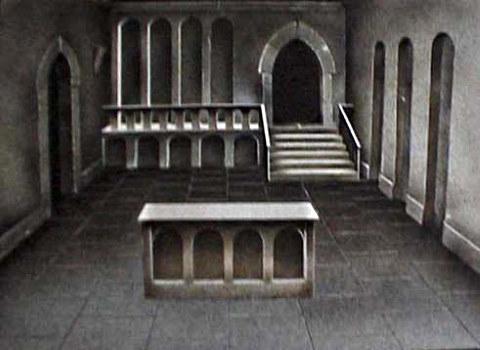The much-loved handpainted designs of Knightmare's early dungeon rooms were the work of artist and illustrator, David Rowe.
By the 1980s, David was an illustrator of computer game artwork. It was this that drew him to the attention of Knightmare creator and gaming enthusiast, Tim Child.
Tim had seen an opportunity to create a fantasy gaming environment through television, but it needed the artwork to bring it to life.
David was asked to create some test rooms, before later becoming the principal artist for the first three years of the show.
Matching to a grid
As an illustrator, David was used to working to briefs and constraints. But Knightmare posed a different challenge – how to create artwork that would match the exact dimensions of the studio.

The answer was a grid that copied the exact view from the camera. Tim Child consulted with French special effects expert, Jean Peyre, to create a series of grids that would reflect the exact view of the camera.
This wasn't just vital for perspective, but also for set design. When one of David's finished paintings contained a wellway, a staircase, or a rocky chasm, a corresponding blue prop needed to be in the exact same position on the studio floor for the overlay to work.

The commission for a dark and mysterious environment captured David's imagination. He reveals in his book, 'The Art of Knightmare' that he particularly enjoyed creating techniques to recreate wet stone and an aged effect.
From airbrush to photoshop
Years later, David was asked to design Lord Fear’s domain for the Geek Week episode, which was released to YouTube in 2013.

This was done by scanning and using Photoshop, eclipsing the early methods of faxing drafts. Some of the columns were produced as textured models for close-up shots, David revealed.
Original handpainted rooms




DownloadBomb Room Desktop (759.84kB)

DownloadShield Room Desktop (1.13MB)



